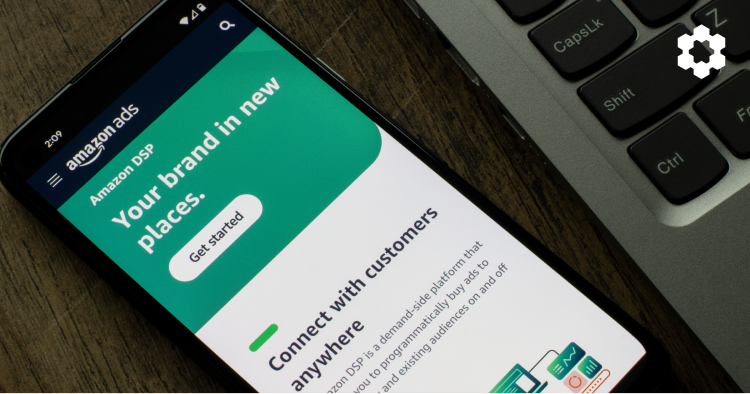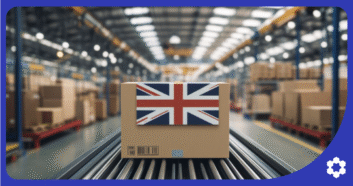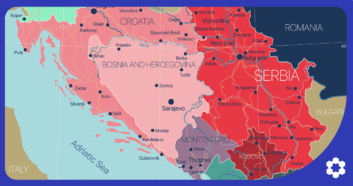This year’s amaNordic 2024 event provided valuable insights for Amazon sellers, especially those aiming to expand internationally. Attendees left with actionable tips, from advanced ad strategies to influencer marketing.
A key session from Carbon6’s Francesco Racnelli highlighted the power of Demand-Side Platform (DSP) advertising combined with external Amazon traffic, showing how brands can expand their reach and boost sales. (DSP automates ad buying, helping businesses target specific audiences across digital channels).
By also leveraging external traffic, like influencer partnerships or targeted Google and Facebook ads, sellers can increase visibility to international customers.
This article will cover how integrating DSP and external traffic can help sellers grow at a global scale.
DSP Advertising: A Key Tool for International Sellers

Rising ad costs on Amazon, particularly during high-traffic periods like holidays, make DSP a valuable tool for international sellers. Amazon DSP is a tool that sellers can use to target audiences on and off Amazon.
While many sellers are familiar with Sponsored Product ads, DSP offers more precise targeting capabilities based on customer behaviour and demographics. This allows sellers to maximise their advertising effectiveness and better allocate their budgets, especially during peak shopping times when costs can escalate.
How Amazon DSP Works
DSP allows sellers to create display ad campaigns that reach potential customers across the web, beyond Amazon’s marketplace. This can be particularly useful for retargeting shoppers who have shown interest in your products but haven’t made a purchase and for cross-selling to existing customers interested in complementary products.
DSP offers sellers a more targeted approach, with audience-based strategies using Amazon’s 1st-party data rather than relying solely on keyword targeting.
Here’s a look at how to use Amazon Demand Side Platform, along with use cases to highlight its capabilities.
Programmatic Advertising
At its core, Amazon DSP operates on a programmatic advertising model, which automates the buying and selling of ad inventory in real-time. This means that advertisers can set their targeting criteria and budget, and the platform will handle the bidding for ad placements on their behalf.
Imagine a fitness brand launching a new line of smartwatches. They want to target health-conscious individuals aged 25-45 who have previously shown interest in wearable technology.
By using Amazon DSP, they can set parameters for their campaign to ensure their ads are served specifically to this audience across various platforms, including other ecommerce sites, blogs about fitness, and social media.
Audience Targeting
One of the key features of Amazon DSP is its targeting options. Advertisers can reach potential customers based on a variety of criteria, including demographics, shopping behaviours, interests, and past interactions with products. This granularity ensures that ads are displayed to the most relevant audiences.
Take a skincare company that wants to introduce a new anti-aging serum as an example. They can target users who have previously purchased anti-aging products on Amazon, as well as those who frequently browse beauty blogs and skincare-related content. This targeted approach increases the likelihood of conversion since the ads are reaching individuals who have already shown interest in similar products.
Creative Ad Formats
Amazon DSP supports a range of ad formats, including display ads, video ads, and native ads. Advertisers can choose the format that best aligns with their campaign goals and audience preferences. This flexibility allows brands to create engaging and visually appealing advertisements that resonate with their target consumers.
A travel agency launching a campaign to promote vacation packages can use eye-catching video ads showcasing stunning destinations. By placing these ads on relevant travel blogs and across Amazon’s network of third-party websites and apps, they can capture the attention of potential travellers at various stages of the decision-making process.
Cross-Channel Advertising
Amazon DSP allows advertisers to run campaigns across multiple channels, including desktop, mobile, apps, connected TVs (such as Fire TV), and Amazon-owned sites. This cross-channel approach ensures that brands can maintain a consistent presence and reach customers wherever they are browsing, streaming, or engaging online.
A home goods retailer can run a campaign promoting a new collection of furniture. They might use Amazon DSP to display ads on Amazon’s product pages, send targeted ads to customers browsing home improvement sites, and run remarketing campaigns across Amazon’s network and third-party websites to re-engage users who visited their site but didn’t complete a purchase.
Measurement and Optimization
Amazon DSP provides detailed reporting and analytics tools to help advertisers track the performance of their campaigns. This data allows brands to measure key metrics, such as impressions, clicks, and conversions, and optimise their strategies based on real-time insights.
Let’s say an online clothing store launches a back-to-school campaign using Amazon DSP. After a week, they notice that their video ads are generating high engagement but low conversions. Analysing the data can help them realise that their landing page needs improvement. They can then make adjustments to the landing page and refine their targeting, ultimately leading to increased conversions.
DSP advertising companies like DSP Prime typically have teams of experts who understand the nuances of programmatic advertising. They can help design, manage, and optimise campaigns tailored to specific business goals, ensuring that ads reach the right audience effectively.
Integration with Amazon Advertising Ecosystem
One of the big advantages of DSP is its integration with the broader Amazon advertising ecosystem. Advertisers can seamlessly coordinate their DSP campaigns with other Amazon ads, such as Sponsored Products and Sponsored Brands, ensuring a cohesive strategy across all platforms.
A beverage brand planning to launch a new organic juice can use Amazon DSP to create awareness and reach potential customers while simultaneously using Sponsored Products to feature their existing juice line. This coordinated approach enhances overall brand visibility and encourages customers to explore the new product when it launches.
The Role of External Traffic in Scaling Your Amazon Business
In addition to Amazon’s internal advertising tools, driving off-Amazon traffic to your listings from platforms like Google, social media, and influencers can significantly improve your product’s ranking and visibility within Amazon’s ecosystem.
Off-Amazon advertising platforms like PixelMe can help track and optimise this traffic, ensuring your campaigns are driving meaningful results, such as conversions, rather than just clicks.
While external traffic may initially result in lower conversion rates compared to internal Amazon traffic, the long-term benefits in terms of increased visibility and Amazon product ranking make it a strategy worth considering for global sellers.
How to Drive External Traffic to Amazon
Driving external traffic to Amazon is essential for increasing visibility, improving rankings, and ultimately boosting sales. Here’s a step-by-step approach to effectively drive external traffic to your Amazon listings.
Identify Your Target Audience
Before launching any external traffic campaign, understand who your target customers are. Research demographics, interests, and online behaviour to create a profile of your ideal buyer.
Thinking like your customer is key. By digging through consumer behaviour data, sellers can make more informed decisions on product listings, pricing, and promotions. This customer-first approach is particularly important in a marketplace where attention spans are limited and competition is plentiful.
Choose External Traffic Sources
Select the platforms where your target audience spends the most time. Common external traffic sources include:
- Social Media: Facebook, Instagram, Pinterest, and TikTok.
- Search Engines: Google Ads for keyword-based advertising.
- Influencer Marketing: Collaborate with influencers who align with your brand to reach their followers.
Create Engaging Content
Develop compelling content that resonates with your audience. This could be blog posts, social media posts, videos, or ads that showcase your product’s benefits.
For example, create a short video demonstrating how your eco-friendly cleaning products work, highlighting their effectiveness and environmental benefits.
In addition, user-generated content (UGC), particularly from influencers, is becoming increasingly important. Incorporating influencer content not only boosts conversions but can also reduce product returns. For instance, customers who engage with authentic, relatable content are more likely to make confident purchasing decisions, leading to fewer returns.
Use Tracking Links
Utilise tracking links, such as those created by tools like PixelMe, to monitor the performance of your external traffic campaigns. This helps you determine which sources are driving traffic and conversions.
Launch Your Campaign
Deploy your content across the selected platforms. Make sure to include clear calls-to-action (CTAs) that direct users to your Amazon listing.
In your Instagram post, include a caption like, “Get your eco-friendly cleaning solution on Amazon! Click the link in our bio to shop now!”
Optimise Your Listings
Ensure your Amazon listings are optimised for conversions. This includes using high-quality images, compelling product descriptions, and strategic keywords.
Monitor and Adjust Your Strategy
Regularly check your analytics to see how your external traffic campaigns are performing. Look at metrics such as click-through rates (CTR), conversion rates, and return on ad spend (ROAS).
If you notice that your Google Ads are performing well but social media ads aren’t converting, consider reallocating your budget to focus more on the successful channels.
Retarget Visitors
Use retargeting ads to reach users who clicked on your links but did not complete a purchase. Platforms like Amazon DSP, Facebook and Google offer retargeting options that can remind potential customers about your products.
FAQs: Amazon DSP Advertising and External Traffic

What is a DSP seat?
To run DSP campaigns, you need access to a DSP seat. Typically, obtaining your own Amazon DSP seat requires a monthly ad spend of at least $100,000. However, you can leverage our DSP seat at DSP Prime by Carbon6 for your campaigns. The minimum monthly spend for this option is $5,000, and it’s generally advisable to allocate about 15% to 20% of your Amazon PPC budget toward DSP for optimal results.
How can I make my brand stand out against similar products?
Using Amazon’s Demand-Side Platform (DSP) allows for highly targeted ads, enabling you to highlight your brand’s unique value proposition. By tailoring promotions through DSP and combining them with external traffic sources like Google and social media, you can ensure that your brand has a broader presence, giving you a competitive edge.
How detailed can DSP targeting be?
DSP provides extremely specific audience targeting, allowing sellers to reach customers based on shopping behaviours, demographics, geographic locations, and even prior interactions with your brand. This level of precision enables you to create personalised ad campaigns that resonate more deeply with your target audience.
Is external traffic worth the effort?
Yes, driving external traffic, while potentially yielding lower initial conversion rates, has substantial long-term benefits. By sending traffic from platforms like Google, Facebook, and Instagram to your Amazon listings, you can improve your product rankings and visibility. Amazon often rewards sellers who bring external traffic with better organic rankings and a 10% Brand referral bonus.
Is DSP suitable for smaller sellers?
Though DSP often requires a higher initial investment, it can be beneficial even for smaller sellers. For those generating around $3 million annually, starting with a modest retargeting campaign can help test the waters before scaling up. A smaller budget can still yield impressive results if the campaigns are well-targeted and managed.
What external traffic sources should I prioritise?
The best external traffic source depends on your campaign’s goals. For product ranking and visibility, Google Ads or influencer marketing may be more effective. For brand awareness, paid social ads on platforms like Facebook or Instagram could work better. Each traffic source complements your DSP advertising campaigns by driving high-quality visitors to your Amazon listings.
Will driving external traffic hurt my Amazon rankings if it doesn’t convert well?
Not necessarily. Using tools like PixelMe to optimise external campaigns can actually improve conversion rates while boosting your Amazon rankings. Even if external traffic results in lower conversion rates initially, Amazon often rewards sellers for bringing in outside traffic, which can lead to a better organic ranking over time.
How much cheaper should my B2B prices be to remain competitive?
Offering a discount of 5% to 10% on B2B pricing can make your products more attractive to business customers, who often buy in bulk. Competitive B2B pricing is crucial to standing out, especially if you’re competing with larger sellers.
How long does it take to see profitability with DSP?
This varies by category and product, but many sellers see profitability within two to three months. Brands in highly competitive niches may take longer, depending on the effectiveness of their campaign management.
How can I track the results of tailored promotions?
You can track the performance of brand-specific promotions via Seller Central, where you’ll find dashboards displaying statistics like sales, discounts, and audience engagement.
What is the typical cost to run a DSP campaign?
A common recommendation is to allocate around 15% to 20% of your Amazon PPC budget to DSP. For example, if you’re spending $100k on ads per month, around $15k to $20k should go toward DSP. The minimum spend to run a DSP campaign effectively is usually around $5k per month.
Growing Your Amazon Business with DSP Advertising and External Traffic
To expand your Amazon business internationally, leveraging both DSP advertising and external traffic is key. Here’s how you can get started:
- Begin with Retargeting: Use DSP advertising to retarget customers who have viewed or interacted with your products but haven’t yet made a purchase. This strategy is cost-effective and highly focused, allowing you to capture potential buyers who are already interested in your offerings.
- Drive External Traffic: By directing external traffic from platforms like Google Ads, Facebook, or Instagram to your Amazon listings, you can significantly boost your product’s ranking. Tools like PixelMe can help you track and optimise these campaigns to ensure they’re driving the right kind of traffic—those likely to convert.
- Build a Cohesive Brand Presence: Creating a recognisable brand across multiple channels—both on and off Amazon—enhances customer loyalty and sets you apart from competitors. Your messaging, visual identity, and overall customer experience should be consistent across all platforms.
Scaling your Amazon business requires a blend of internal and external strategies. With DSP’s precise targeting and external traffic sources working together, you’ll be able to reach a broader audience, increase sales, and improve your rankings on Amazon.
Take advantage of Carbon6’s DSP Prime to tap into programmatic advertising without the hefty ad spend requirement. DSP Prime’s expert team can help optimise campaigns to suit your goals.
As you look to grow your Amazon business, be sure to catch Carbon6 at upcoming Amazon seller events. And don’t forget to stay current with the latest ecommerce news by subscribing to our weekly Amazon seller newsletter, where we deliver hand-picked news and updates straight to your inbox.




